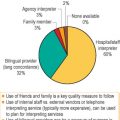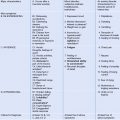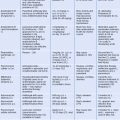CHAPTER 53 Religion and Spirituality in the Lives of Immigrants in the United States
Introduction
In the history of the United States, religion has frequently played a key role in decisions to emigrate, whether to be able to practice in a particular way, or to avoid ways of life imposed by other religious groups. As Jasso et al. observe, ‘The religious composition of the US population thus reflects the evolving history of infringements on religious liberty around the world and the steadfast American freedoms.’1 (It bears adding that, in some cases, immigration is driven not simply by the appeal of such freedoms, but by US interventions in overseas labor markets and/or by the deadly effects of regimes trained or supported by the US.)
Defining Terms
Such definitions have crossed over into medical literature in a variety of ways. In some instances, ‘religion’ and ‘spirituality’ go undefined and undifferentiated,2 or are treated as functionally synonymous.3 Authors sometimes acknowledge a ‘lack of conceptual clarity in the research literature,’ but bypass the issue by suggesting that individuals have ‘little difficulty rating themselves on their own level of spirituality.’4 Citing the Multidimensional Measurement of Religiousness/Spirituality for Use in Health Research,5 Kilpatrick et al. suggest that ‘religiousness has specific behavioral, social, doctrinal, and denominational characteristics that are shared by a group. By contrast, spirituality is concerned with the transcendent, addressing ultimate questions about life’s meaning, with the assumption that there is more to life than what we see or understand.’6 Koenig, too, differentiates between the social and the individual: ‘Spirituality is more individualistic and self-determined, whereas religion typically involves connections to a community with shared beliefs and rituals.’ He goes on to recommend the term ‘spirituality,’ in conversations with patients, construing it as the broader and more inclusive of the two terms.7 Peterman acknowledges, though, that such meanings have changed over recent decades.8
Up until the 1960s and 1970s, religion was seen as a broad construct, encompassing individual and institutional elements as well as spirituality. More recently, religion has become more narrowly defined, and spirituality has become distinguished from religiousness, or the practice of religious behavior. Recent definitions of spirituality include dimensions such as a personal search for meaning and purpose in life, connections with a transcendent dimension of existence, and the experiences and feelings associated with that search and that connection. Religion is seen, in contrast, as participation in the institutionally sanctioned beliefs and activities of a particular faith group.8
It is less common for medical authors to address the challenges posed by the growing religious pluralism of the United States, and to link such challenges with the broader issues of cross-cultural practice, although some do point to the problems of positing universal, normative definitions.9,10
The work of religion scholars, however, points in a number of different directions. First, it is difficult if not impossible to come up with a definition – or even a group of variables – that fits all traditions for either ‘religion’ or ‘spirituality.’ We might better say that religions may grow out of relationships with nature, or with God or gods. Religions reflect the deepest or highest human concerns, as responses to something sacred. Religions both express and shape people’s sense of meaning, their understanding of what life is about. Religions can bring about profound experience, and find expression in rich systems of symbols. Religions may hold communities together, and influence surrounding societies. In some cases, they serve to justify power disparities; in others, they motivate groups to challenge those very disparities.11 People kill in the name of religions; they also heal.
For that matter, people may pick and choose from within a given tradition, customizing their worldview and practice in response to new influences and needs. They may also borrow from other traditions – an increasingly common phenomenon in American communities where different cultural groups live in proximity to one another. Or, people may shore up and tighten the boundaries of their reli gious group in new ways, in order to assert their identity in a new place. Immigrants and refugees may take great pains to relocate their religious communities and practices, while also modifying them in the process. Where temples proliferated in the country of origin, a group in the US may have to adjust to using a private home, or a collectively purchased suburban ranch house, as its religious center. Home-based practice may take on increased importance. For some people, ‘religion’ may come to serve as the operative term for what they do, and for what matters to them; for others, ‘spirituality’ captures key features; and for still others, both are meaningful. Religions, spiritualities, and how people employ both terms are routinely in a state of flux. For clinicians, therefore, it becomes particularly important not to assume that generic definitions capture the lived experience of patients.
Religious Globalization
Developments abroad may have a profound impact on immigrant and refugee groups, especially in a transnational world, where people cross and re-cross borders, and where internet connectivity and media outlets alert one almost instantly to events around the globe. This transnational reality has several key characteristics. For example, immigrants are better able to sustain strong ties with their homelands than ever before.12 In many cases, therefore, their social, political, economic, and cultural frames of reference include not only their place of residence in the US, but also other sites where relatives and compatriots have settled, as well as the home culture abroad. Thus, transnationalism entails networks throughout the US and overseas.
In this connection, people may maintain active connections with the religious communities back home. As McAlister observes of Haitian immigrants in New York, for example, religious festivals such as the Fèt Vièj Mirak (the Feast of the Miraculous Virgin) on East 115th Street do not simply replace the corresponding celebration in Haiti. Rather, the Fèt both increases the options for where one can commemorate the event, and expands Haitian sacred space into a new territory – an American city.12 Such festivals allow people ‘to create the proper setting to honor the saint, to renew life, to reaffirm identity even in exile, and to create greater unity among the saint’s people.’13 As they do so, they transform the American religious arena as well.
Moreover, when they return to Haiti, people do so with a redefined, internationalized understanding of their religious world, and visits may be planned accordingly. For those involved in the tradition of Vodou, for example, certain kinds of spiritual work can be undertaken in the US, such as healings, or personal crises involving work or love. However, events such as initiations, funeral rituals, becoming an oungan (priest) or manbo (priestess), or dealing with a problem that interventions in the US have not resolved, all require travel to Haiti.14 Members of different religious communities may increasingly participate in what Marquandt refers to as ‘transnational religious circuits.’15
Within such circuits, the new religious sites provide the opportunity to recreate a part of the home country – a potential refuge into which one can step. There, one can imagine oneself relocated back into a familiar space, where one is recognized and welcomed. Altars, religious iconography of other kinds, and ritual space come together to transplant a setting in which a person’s identity can be asserted. In some cases, where numerous family members and friends from a given location have resettled in American cities, as is the case with migrants moving from Michoacán in Mexico to the Metro-Atlanta area, the result is an internationalized ‘village.’15 Similarly, Fuzhounese immigrants recreate Protestant and Catholic church communities, as well as Buddhist, Daoist, and popular-religion temples in New York City and in other urban centers around the US.16 Transplanted religious communities provide a common ground where people can come together, generate support networks, and tap into often publicly invisible channels for immigration, resettlement, work, and support for engaging governmental and civic institutions.
The gods and saints accompany their devotees, migrating to American soil. The Vièj Mirak is now known to reside in New York City and to extend her blessings from there, as well as from Haiti. The Vodou lwa (guardian spirit) Ezilie Dantò (also represented as Our Lady of Lourdes) once spoke through an oungan to say that she was spending 3 days every week in Miami, to watch out for migrants there.17 The saints’ festivals organized by Mayan exiles in California and the Southwest are grassroots activities that not only assert ethnic pride, but also honor the holy patrons who have made the journey with the immigrants and the refugees.13
Spirit mediums from the Fuzhou area of mainland China have resettled in such disparate places as New York and Indiana. There, they accept questions – either in the form of handwritten notes or through telephone calls – which they then direct to the god He Xian Jun through trance possession. Peti tioners may ask the god’s opinion ‘about everything from business ventures to children’s names to the potential success of petitions for political asylum. They come to pray for the health of sick relatives and to give thanks for safe passage across the ocean with snakeheads from China.’18 On the birthday of Guan Yin, Bodhisattva of compassion and mercy, immigrants from Fuzhou come together at the temple of He Xian Jun to celebrate. The establishment of such religious sites in the US in turn may elevate the standing of related groups in the home country. That a large Chinese Buddhist temple now flourishes in Houston, attracting Westerners as well as Chinese immigrants and, on occasion, being covered by American media, serves as a sign to Taiwanese Buddhists that Buddhism is seen as both legitimate and important in the US.19
Communication between adherents both in the country of origin and in the US is enhanced by the use of cassette and video recorders. Not only do tape recordings take the place of written letters, for immigrants who are illiterate, but they may also record religious and healing ceremonies for those who cannot be present, but who ‘attend’ vicariously. Not infrequently, the person making the recording will provide voice-over commentary for the viewer. In traditions involving spirit possession, as in Vodou, the spirits may speak to the tape or video recorder, conveying messages and advice to those who are absent. Chinese Buddhists involved with the Hsi-nan temples record talks and ceremonies, and videotape special events, storing the tapes in a growing library and, not infrequently, copying them and sending them to Taiwan and, sometimes, to mainland China.19 Practitioners, spirits, and gods thus speak to one another across a transnational space.
Moreover, those who avail themselves of these different kinds of religious resources do not necessarily do so instead of seeking biomedical care. For some, biomedicine was available in their country of origin, albeit in a culturally inflected form. Insofar as biomedicine itself is a cultural system,20,21 immigrants enter the US, in many cases, with preexisting ideas about physicians, clinics, and biomedical interventions, and their relationship to religious systems of healing. The customized combinations designed by patients reflect their understandings of a given health problem, and the different things they believe need to be done for it, within the constraints of social and economic barriers to care. The nature of these customized solutions may remain invisible to biomedical care providers, insofar as patients selectively disclose only what they assume providers need to know or will be open to hearing about. Cultural assumptions about the role and nature of physicians may further influence patients’ decisions about how much to tell doctors about the role of religious involvement in their lives. Generally speaking, however, patients are often delighted to discover that physicians have even a basic awareness of some of the different ways in which religious communities have entered US culture, and of their place in immigrant life.
Institutional Adaptations
Many of the non-Western religious traditions prioritize home-based or small-group religious observance, as is often the case, for example, for Muslims, Hindus, and Buddhists. Such practices may be among those that transplant the most readily and easily to the US. For groups who remain migrants in the US, as with seasonal farm workers from Mexico, collective religious expression may involve lay specialists ‘from curanderas (healers) to rezadoras (prayer specialists) and espiritualistas, who work in the large gaps left by religious institutions.’22 Some groups, in contrast, have well-established congregational systems and experiences that provide models for religious association in the US. This is the case with the Presbyterian Church in Korea as the result of US missionary influence, and with Latin American Catholic congregations influenced by the participatory models of liberation theology. As Vásquez observes, the latter group may challenge church hierarchies more familiar to Irish- and ItalianAmerican Catholics.22
A commonly cited example is Islam, which in Muslim countries does not generally have professional ministers for mosques. Imams are unpaid individuals recognized for their knowledge of the Qur’an and the sayings of the Prophet (hadith).23 By professionalizing the role, and by congregationalizing mosque communities, American Muslims locate themselves within religious frameworks more familiar to the surrounding culture and, by extension, assert their legitimacy. Similarly, Hindu immigrants from India may rework their religious lives to accommodate to the new environment. Raymond Brady Williams characterizes the resulting practices as ‘made in the USA … assembled … by relatively unskilled labor (at least unskilled by traditional standards) and adapted to fit new designs to reach a new and growing market.’24 In India, for example, religious practice generally occurs at home, or through individual or family visits to a temple. Large gatherings are more often reserved for temple festivals, as opposed to weekly gatherings.
The Rev. Tai-Xu (1889–1947), a reformer within Hsi-nan Buddhism, adopted various organizational and social service practices from Christianity, such as founding seminaries and religiously sponsored hospitals, proselytizing in prisons, and officiating at wedding ceremonies (instead of primarily at funeral rituals).19 Conversely, as Yang25 notes, some Christian groups in their countries of origin adopt traditional cultural practices from other religious groups, because these practices are so widespread. Such is the case, for example, among Chinese Christians, who may have observed Qingming, a spring commemoration for the dead and for one’s ancestors, rooted in the Confucian and Buddhist traditions. In the US, however, such practices are not part of the surrounding culture, allowing Chinese Christians to abandon them without feeling out of step.
Stay updated, free articles. Join our Telegram channel

Full access? Get Clinical Tree







